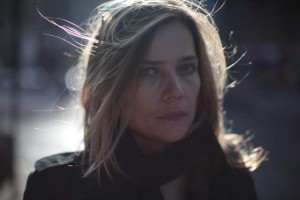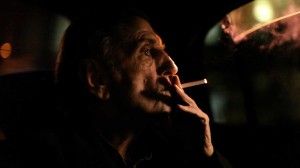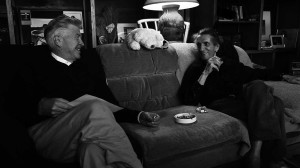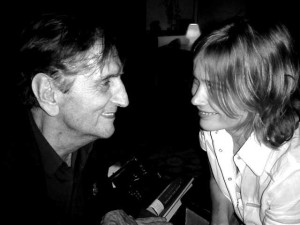
When Swiss filmmaker Sophie Huber became acquainted with legendary character actor Harry Dean Stanton through his prolific body of work, she had little idea that nearly 30 years later, he would become the subject of her most notable film to date. First seeing the actor in the 1980s cult film, Paris Texas, when she lived in Europe, she was taken aback by his distinct onscreen presence. However, after she relocated to Los Angeles in the mid-1990s, she had the chance to meet him in person, which eventually led to their unusual collaboration evolving into the new film Harry Dean Stanton: Partly Fiction. “We had this instant connection,” Huber remembered about their first encounter. “We stayed in touch ever since.“
Some years later, aware of Stanton’s fondness for singing in his free time, Huber decided to document his solo performances. “The way he sounded was so beautiful and moving,” she said. “A lot of people had asked him to record, but he never wanted to do it. I started recording him — just audio. I felt somebody had to do it.”
First recording Stanton at his L.A. home, Huber wanted to push the envelope, a sensitive area with the notoriously reluctant and press shy actor. “I thought it would be great if I could film him too,” Huber said. “He expresses a lot through his face. He absolutely did not want to do the film.”

With Stanton’s refusal to appear on camera, Huber formed a guerilla filmmaking strategy. “I had to build everything around him and then force him to do it,” she recalled. For a touching Mexican song performance, which actually was originally found in Paris, Texas, Huber conceived of an idea to film Stanton in the desert, singing with mariachis. As expected, the actor, at first, declined to participate.
“I went anyway with the Mariachis and showed him that I would film it whether he was in it or not,” she amusingly conveyed. Later, David Lynch and Deborah Harry agreed to be interviewed about their connection with Stanton, which slowly brought the actor around to accepting the film. However, the process that unfolded was anything but conventional.
Huber endeavored to create the eventual film around the centerpiece of Stanton’s initial musical performances. “It would not be what a normal documentary would be like,” she said. “We recorded four songs, and that took away some of the pressure from him.” Seven final songs were featured in the movie out of 15 which were fully recorded by the end of principal photography.
 In the finished work, interviews with Stanton’s collaborators plus Stanton himself are peppered throughout the odd concoction of offbeat commentary by friends and colleagues mixed with the octogenarian singer-actor’s heartfelt musical numbers. “I didn’t want to do a talking heads film,” Huber revealed. “I wanted him to be the leading man and have other people talk about him since I knew that he wasn’t going to talk much. He needs a medium, whether it’s acting or a song to express his feelings. In a way, he’s more truthful in a song or in a part than he is as himself.”
In the finished work, interviews with Stanton’s collaborators plus Stanton himself are peppered throughout the odd concoction of offbeat commentary by friends and colleagues mixed with the octogenarian singer-actor’s heartfelt musical numbers. “I didn’t want to do a talking heads film,” Huber revealed. “I wanted him to be the leading man and have other people talk about him since I knew that he wasn’t going to talk much. He needs a medium, whether it’s acting or a song to express his feelings. In a way, he’s more truthful in a song or in a part than he is as himself.”
To complete the 77-minute movie, Huber shot interviews and performances over a period of two-and-a-half years. “Sometimes, it takes a long time to get to these people to have them respond,” said the filmmaker of her interview subjects. In her own time, Huber did the initial edit of two-and-a-half hours, taking nearly a year to do the rough cut.
 Key in the assembly of footage was thematically connecting the songs and interview segments. “It was important to me because Harry talks about everything being connected in a philosophical way,” Huber said. “Everything would be connected to the [song] before or after.”
Key in the assembly of footage was thematically connecting the songs and interview segments. “It was important to me because Harry talks about everything being connected in a philosophical way,” Huber said. “Everything would be connected to the [song] before or after.”
Certainly, along with being a reluctant interview subject, Stanton was also a standoffish audience member when it came to viewing the final film about him. “He had the DVD for more than half a year but never watched it,” Huber remembered. “He came to a screening at the L.A. Film Festival and liked it. He came down and received a standing ovation and said, “I look so f***ing old.” But he really likes the film. I can tell that he likes the attention. He appreciates that people will see and hear his songs more and know that talent of his. But he would never admit it. He’s an actor after all.”
Harry Dean Stanton: Partly Fiction opened in New York, Sept. 11 at the Village East Cinema on 2nd Ave. and 12th Street and opens in Los Angeles, Sept. 13 at the Nuart Theater.





